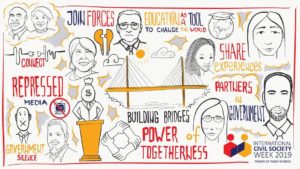We at Mobilisation Lab believe that collaborative, iterative and supportive approaches are fundamental if we are to win change at scale. These principles, so celebrated for their effectiveness in the business world today, were developed and continue to be used by movements of women, LGBTQ+ people, Black folks, Indigenous groups, immigrants and other grassroots communities.
In this important piece, Hanna Thomas of 350.org explores just how Lean-Agile methodologies actually encompass feminist, queer, anti-authoritarian and progressive ways of working—because that’s where they originated. Her writing originally appeared on Medium and is republished here with permission.
—
When Lean-Agile methodologies are brought up in progressive spaces, they’re often met with a suspicious side-eye. After all, as Audre Lorde said, “the master’s tools will never dismantle the master’s house“. Why on earth would we choose a methodology so beloved by big business, and how would we use it to deconstruct the harmful systems they impose on us?
I understand this line of thinking. Lean-Agile principles are foundational in the tech sector and getting take-up in other for-profit industries. Many of the well-known books that promote Lean-Agile (The Lean Start-up, and The Age of Agile, for example) include case studies drawn from big corporations and the military. The Age of Agile even includes an example on how the US military used Lean-Agile principles to build a fighter jet. To some in progressive spaces this may feel immoral at worst, irrelevant at best.
Plus, the history of Lean-Agile methodologies starts in large-scale manufacturing. Car manufacturer Toyota came up with a set of principles called The Toyota Way in the 70s, and organised them into 4 sections:
- Long-Term Philosophy
- The Right Process Will Produce the Right Results
- Add Value to the Organization by Developing Your People
- Continuously Solving Root Problems Drives Organizational Learning
In the 90s, these principles were adopted and built upon by the software development world, culminating in 17 white guys gathering in a ski lodge in Utah called Snowbird (I know) and writing The Agile Manifesto in 2001:
- Individuals and interactions over processes and tools
- Working software over comprehensive documentation
- Customer collaboration over contract negotiation
- Responding to change over following a plan
The men who wrote the manifesto are unclear on whether they invited any women. Even so, the thing I notice from both the manifesto, the accompanying principles, and the fact that these 17 men call themselves “organizational anarchists” is that what they came up with is inherently subversive, anti-authoritarian, and feminist. There is an emphasis on self-organising, collaboration, experimentation, welcoming change, and building high-trust and supportive relationships.
Compare the Agile manifesto with the Riot Grrrl Manifesto, written 10 years earlier in 1991 by punk singer Kathleen Hanna and her band Bikini Kill. The underground feminist punk movement was underpinned by statements such as:
- BECAUSE us girls crave records and books and fanzines that speak to US that WE feel included in and can understand in our own ways.
- BECAUSE we wanna make it easier for girls to see/hear each other’s work so that we can share strategies and criticize-applaud each other.
- BECAUSE we are interested in creating non-hierarchical ways of being AND making music, friends, and scenes based on communication + understanding, instead of competition + good/bad categorizations.
- BECAUSE we see fostering and supporting girl scenes and girl artists of all kinds as integral to this process.
- BECAUSE I believe with my wholeheartmindbody that girls constitute a revolutionary soul force that can, and will change the world for real.
The language is different, but the essence is the same — collaborative, supportive, non-hierarchical relationships that empower users and embrace change.
Jennifer Armbrust’s principles of a feminine economy lay it out even more clearly. Collaboration, ease, asking questions, cyclical growth, empathy, and interdependence are all such important cornerstones of a successful product development cycle.
The 17 writers of the Agile manifesto didn’t invent the concepts of collaboration, experimentation, or support, but they were attracted to these principles. Perhaps they had seen their fathers live lives of quiet desperation in top-down bureaucracies, and they wanted something different for themselves. You can’t blame them — but it would have been admirable if they had given credit to the many grassroots movements (like Riot Grrrl) and organisations who had already been working like this all along.
For example, Sister Corita Kent, a catholic nun who used pop art to promote anti-racist, anti-war slogans during the 60s and 70s, hung up these rules for her art classroom where she taught:
- Rule 1: Find a place you trust, and then try trusting it for awhile.
- Rule 2: General duties of a student: Pull everything out of your teacher. Pull everything out of your fellow students.
- Rule 3: General duties of a teacher: Pull everything out of your students.
- Rule 4: Consider everything an experiment.
- Rule 5: Be self-disciplined. This means finding someone wise or smart and choosing to follow them. To be disciplined is to follow in a good way. To be self-disciplined is to follow in a better way.
- Rule 6: Nothing is a mistake. There’s no win and no fail. There’s only make.
- Rule 7: The only rule is work. If you work it will lead to something. It’s the people who do all of the work all of the time who eventually catch on to things.
- Rule 8: Don’t try to create and analyze at the same time. They’re different processes.
- Rule 9: Be happy whenever you can manage it. Enjoy yourself. It’s lighter than you think.
- Rule 10: “We’re breaking all the rules. Even our own rules. And how do we do that? By leaving plenty of room for X quantities.” -John Cage
- Helpful Hints: Always be around. Come or go to everything. Always go to classes. Read anything you can get your hands on. Look at movies carefully, often. Save everything — it might come in handy later.
Aren’t these principles incredibly close to the way that we talk about Lean-Agile? Compare Rule 4 (consider everything an experiment), and Rule 6 (nothing is a mistake. There’s no win and no fail. There’s only make), with the lean concept of the minimum viable product.
Or, how about this from Jack Halberstam’s The Queer Art of Failure:
The queer art of failure involves the acceptance of the finite, the embrace of the absurd, the silly, and the hopelessly goofy. Rather than resisting endings and limits, let us instead revel in and cleave to all of our own inevitable, fantastic failures.
Isn’t this the same principle that Astro Teller uses, head of Google X, when he offers his employees a bonus when they fail?
And what about Octavia E. Butler, African American author of science fiction that delivers searing critiques of present-day hierarchies, in poetic agreement with the Agile principle of “Responding to change over following a plan”:
All that you touch
You Change.
All that you Change
Changes you.
The only lasting truth
Is Change.
God
Is Change.
I use these examples to serve the idea that what we now call Lean-Agile principles are principles that are already taken for granted within progressive social movements, and which are deeply necessary to succeed.
One way of making Lean-Agile methodologies more palatable to progressive and non-profit spaces could be to define them in a different way. To acknowledge that Agile encompasses feminist, queer, anti-authoritarian, progressive ways to organise our work and shape our contexts, and that so many of us are aligned with them already.
How many of these principles might apply to a progressive group or organisation you know of or work with?
- Collaboration over hierarchy
- Service-oriented
- Experimental
- Anti-authoritarian
- Playful
- Iterative
- Supportive and anchored in relationship
Then these groups and organisations are already adopting some Lean-Agile practices! Tech companies and their counterparts shouldn’t get to keep these methodologies for themselves and get the glory for figuring it out. They’re succeeding because they’re using methods that have been proven over and over again to help groups survive and thrive. Failing early and often is something that farmers know about intimately (“it’s great if you can fail often and early”). Collaborative and supportive cultures are something that immigrant and working class communities have had no choice but to build.
If you’re in a group or organisation that is looking to hire people well versed in Lean-Agile, consider broadening your search beyond those who’ve had experience in tech or start-ups. 350.org’s Product Team is led by a woman of colour, and encompasses people of many different backgrounds, abilities, sexualities, races, and genders, from the United States to Kenya, Europe, South Africa, the Philippines, and Nepal.
It’s an amazing team, the best I’ve ever been a part of. Because you know who are particularly well qualified in the principles of experimentation, of collaboration, of support and iteration? Women, LGBTQ+ people, people from the global south, immigrants, people of colour, people with chronic health conditions. They bring with them all of the skills your group or organisation needs to go Agile.
We’re working towards the global climate strikes on September 20th and 27th right now, building the technical infrastructure to make it possible for people to find and register events around the world. There is a lot to do. And we do it by embracing all of the principles above.
We have daily stand-ups where we share priorities, but hold them loosely knowing they might (definitely will) change. We have a slack channel where we post our problems and can pile on to support each other to solve them. We share the highs and lows of our work and lives, and post pictures we’ve taken each week in a ritual that reminds each other than we are human beings, not robots. We go out and talk to all the campaigners and organisers we serve, and then we centre their needs in our quarterly roadmap. We try the smallest solution first, and go from there. There is no one person setting the agenda. Everyone is so important, and has a crucial role to play.
Agile is described as a mindset. But let’s call it what it is and skip the middleman. Successful organisations aren’t ones that adopt an “Agile mindset”. Successful organisations are ones that adopt a feminist, queer, anti-establishment, progressive mindset — one that is flexible, experimental, pushes boundaries, self-organises, and acts in service of community.
There are two tasks. If you’re at an organisation that defaults to a macho style of command and control and is mired in bureaucracy (let’s be honest, there are plenty), the first task is to notice and appreciate collaboration, experimentation, self-organising, and support wherever you see it, then fiercely defend and champion the projects and people involved.
The second task is to recognise when you’re on fertile ground. If you’re in a team that centres feminist, queer, anti-establishment, progressive values and someone references Lean-Agile methodologies sometime soon — know that you are already there. You already have the mindset needed to try out the frameworks — whether it’s scrums, sprints, roadmaps, or stand-ups — and make them a stunning success.
Top image: Flyer for the 1992 Riot Grrrl Convention. By Flickr user rockcreek. CC BY 2.0.




